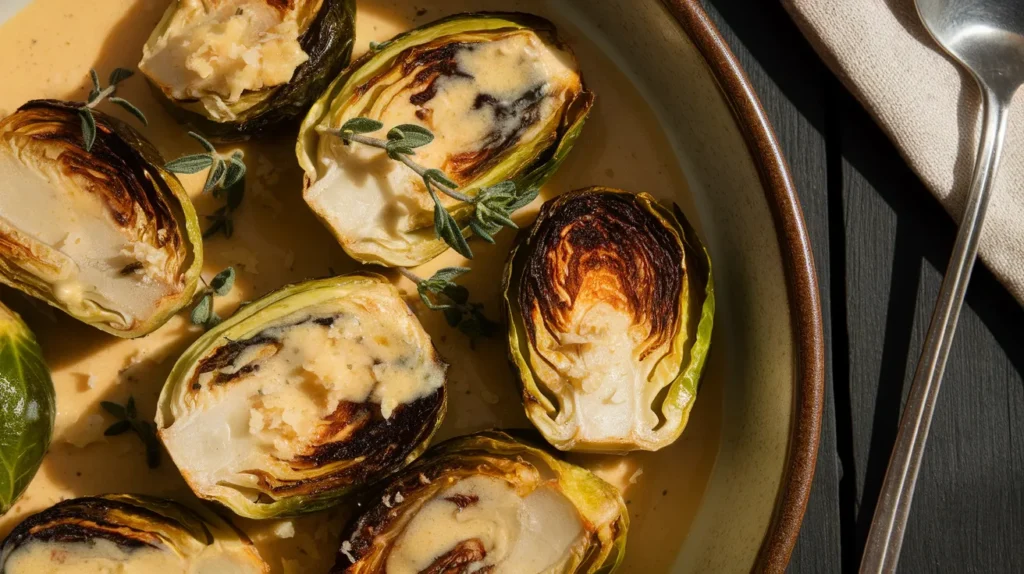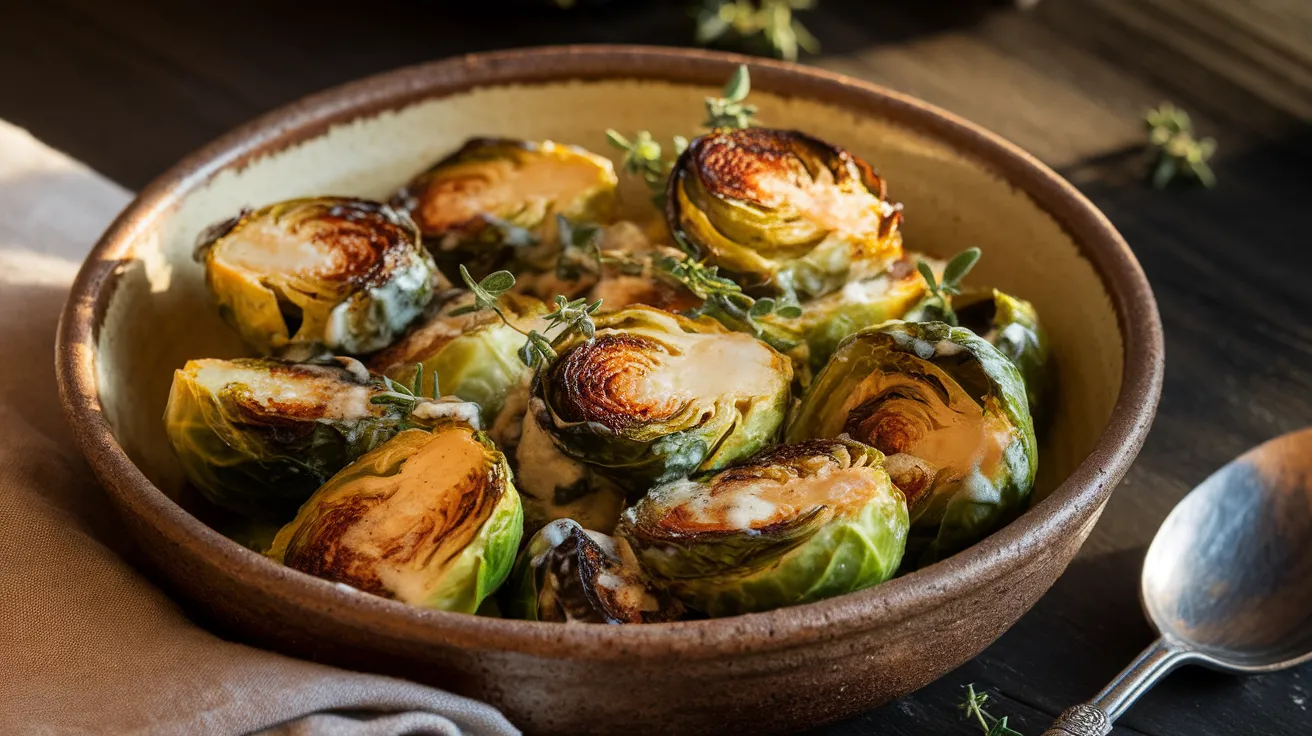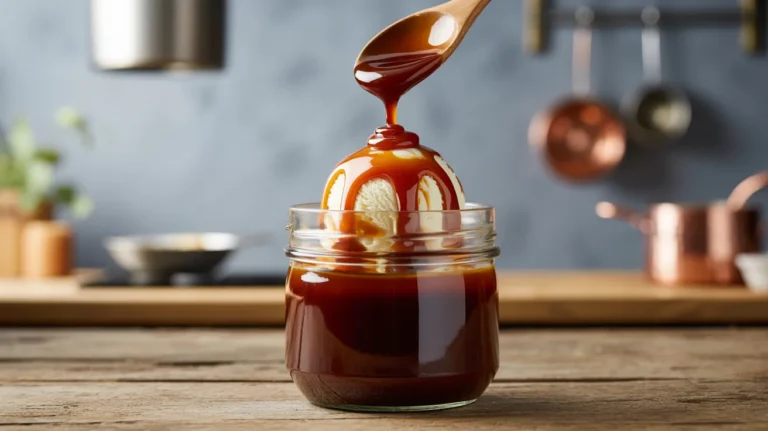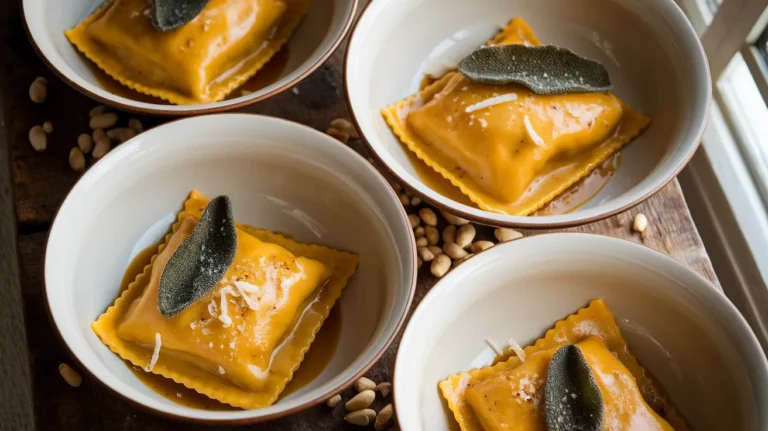This foolproof sauce for brussel sprouts recipe turns bitter vegetables into a restaurant-quality side dish that everyone loves. Our creamy, garlic-infused sauce for brussel sprouts creates the perfect coating that transforms even the most skeptical eaters into fans of this nutritious vegetable.
SERVES: 4 | PREP: 15 MIN | COOK: 25 MIN | TOTAL: 40 MIN
Ingredients for the Best Sauce for Brussel Sprouts
For the Brussels Sprouts:
- 2 lbs fresh Brussels sprouts, trimmed and halved
- 2 tbsp olive oil (extra virgin preferred)
- 1 tsp kosher salt
- 1/2 tsp freshly ground black pepper
For the Creamy Garlic Sauce:
- 4 tbsp unsalted butter
- 4 large cloves garlic, minced finely
- 1/4 cup heavy cream (room temperature)
- 1/4 cup freshly grated Parmesan cheese
- 2 tbsp fresh lemon juice
- 1 tsp Dijon mustard
- 1/4 cup low-sodium chicken broth
- 2 tbsp fresh thyme leaves (or 1 tsp dried)
- Salt and white pepper to taste
Detailed Step-by-Step Sauce for Brussel Sprouts Instructions
Phase 1: Preparing Your Brussels Sprouts (15 minutes)
Step 1: Preheat and Position Place your oven rack in the center position and preheat to 425°F (220°C). This high temperature is crucial because it caramelizes the natural sugars in the Brussels sprouts while creating crispy edges. Line a large rimmed baking sheet with parchment paper to prevent sticking.
Step 2: Inspect and Sort Brussels Sprouts Examine each Brussels sprout carefully. Look for firm, bright green heads without yellow or black spots. Discard any that feel soft or have damaged outer leaves. Fresh Brussels sprouts should feel heavy for their size and make a slight squeaking sound when rubbed together.
Step 3: Trim the Stem End Using a sharp paring knife, cut about 1/4 inch off the bottom stem end of each Brussels sprout. This removes the tough, fibrous part that can taste bitter. You’ll know you’ve cut enough when you see the pale interior.
Step 4: Remove Loose Outer Leaves Gently pull away any loose, damaged, or yellowing outer leaves. These can become bitter when roasted. Don’t worry if a few leaves fall off during this process—they’ll actually become deliciously crispy in the oven.
Step 5: Cut for Even Cooking Cut each Brussels sprout in half lengthwise, from stem to tip. Try to make the pieces as uniform as possible so they cook at the same rate. If you have very large Brussels sprouts (bigger than a golf ball), cut them into quarters instead.
Step 6: The Critical Washing Step Place the cut Brussels sprouts in a large colander and rinse under cold running water. Gently agitate them with your hands to remove any dirt or debris that might be hiding between the leaves. This step is important for food safety and flavor.
Step 7: Dry Completely This is where many beginners make a mistake. Pat the Brussels sprouts completely dry with clean paper towels or a kitchen towel. Any remaining water will create steam in the oven, preventing the crispy caramelization we want. Let them air dry for 2-3 minutes while you prepare your baking sheet.
Step 8: Season and Oil In a large mixing bowl, toss the dried Brussels sprouts with olive oil, salt, and pepper. Use your hands to ensure every piece is evenly coated. The oil should lightly glisten on the surface but not pool in the bottom of the bowl.
Phase 2: Roasting for Perfect Texture (20 minutes)
Step 9: Arrange for Maximum Caramelization Place the Brussels sprouts cut-side down on your prepared baking sheet. This is crucial—the cut side against the hot pan creates the beautiful golden-brown caramelization. Space them so they’re not touching each other. Crowding causes steaming instead of roasting.
Step 10: The Roasting Process Slide the baking sheet into your preheated oven on the center rack. Set a timer for 18 minutes. Resist the urge to open the oven door and check on them—this releases heat and disrupts the cooking process.
Step 11: Check for Doneness After 18 minutes, carefully remove the baking sheet and check one Brussels sprout. The cut side should be golden brown to deep caramel colored, and a fork should pierce the thickest part easily. If they need more time, return to the oven for 2-4 more minutes.
Step 12: Test for Perfect Texture A properly roasted Brussels sprout should be tender throughout but still have a slight bite—not mushy. The outer leaves should be crispy and slightly charred while the center remains creamy. This contrast in textures is what makes this sauce for brussel sprouts recipe so appealing.
Phase 3: Creating Your Signature Sauce for Brussel Sprouts (8 minutes)
Step 13: Start with Brown Butter In a large skillet or sauté pan, melt the butter over medium heat. Watch carefully as it foams and bubbles. After about 2-3 minutes, the butter will start to turn golden and smell nutty. This brown butter adds incredible depth to your sauce for brussel sprouts.
Step 14: Add Garlic with Precision When the butter is lightly golden (not dark brown), immediately add the minced garlic. Stir constantly with a wooden spoon for exactly 30-45 seconds. The garlic should become fragrant and just start to turn golden. If it browns too much, it becomes bitter and will ruin your sauce.
Step 15: Deglaze and Build Flavor Pour in the chicken broth while stirring. It will sizzle and steam—this is normal. Use your spoon to scrape up any browned bits from the bottom of the pan. These bits add incredible flavor to your sauce. Let the mixture simmer for 1 minute to reduce slightly.
Step 16: Create the Cream Base Reduce heat to medium-low and slowly pour in the heavy cream while whisking constantly. This prevents the cream from curdling. Add the Dijon mustard and whisk until completely smooth. The sauce should coat the back of your spoon but still flow easily.
Step 17: Add Cheese Gradually Remove the pan from heat temporarily. Add the Parmesan cheese a small handful at a time, whisking after each addition until completely melted before adding more. This prevents the cheese from clumping. The sauce should become glossy and smooth.
Step 18: Balance with Acid Stir in the fresh lemon juice and thyme. The lemon brightens the rich sauce and balances the butter and cream. Taste and adjust seasoning with salt and white pepper. The sauce should be creamy, flavorful, and coat your spoon nicely.
Phase 4: Combining for Perfect Sauce for Brussel Sprouts (3 minutes)
Step 19: Combine While Hot Working quickly, add the hot roasted Brussels sprouts directly to the warm sauce in the skillet. The heat from both components helps the sauce adhere properly to each Brussels sprout surface.
Step 20: Toss with Care Using a large spoon and fork (or tongs), gently toss the Brussels sprouts in the sauce for 30-60 seconds. Be careful not to break apart the Brussels sprouts. Every piece should be glossy and well-coated with the creamy sauce.
Step 21: Final Seasoning Check Taste a Brussels sprout with sauce and adjust seasoning if needed. You might want to add a pinch more salt, a squeeze of lemon, or extra freshly ground pepper. The flavor should be rich, balanced, and irresistible.
Step 22: Serve Immediately Transfer to a warmed serving dish and serve right away while the Brussels sprouts are hot and the sauce is at its creamiest consistency. Garnish with extra thyme leaves or Parmesan if desired.
Chef’s Notes for Perfect Sauce for Brussel Sprouts
• Choose Brussels sprouts that are similar in size for even cooking—this ensures your sauce for brussel sprouts coats uniformly.
• Don’t skip the browning step for the butter—it creates a nutty foundation that elevates the entire sauce.
• Room temperature cream prevents curdling when added to the hot butter mixture.
• Fresh thyme makes this sauce for brussel sprouts restaurant-quality, but dried works if that’s what you have available.
Nutrition Information (Per Serving)
- Calories: 285
- Protein: 12g
- Carbohydrates: 18g
- Fat: 20g
- Fiber: 8g
- Sodium: 420mg
Creative Variations for Your Sauce for Brussel Sprouts
Bacon-Enhanced Sauce for Brussel Sprouts
Cook 4 strips of thick-cut bacon until crispy, then crumble and fold into the finished dish. The smoky flavor pairs beautifully with the creamy base.
Herb-Crusted Brussels Sprouts
Top with 2 tablespoons toasted panko breadcrumbs mixed with fresh herbs for added crunch, similar to techniques in our sauce for broccoli recipe.
Wine-Infused Sauce
Replace the chicken broth with dry white wine for a more sophisticated flavor that’s perfect for holiday entertaining.
Dairy-Free Version
Substitute cashew cream and nutritional yeast for a plant-based sauce that’s equally rich and satisfying, inspired by our sauce for butternut squash ravioli variations.
Storage & Reheating Your Sauce for Brussel Sprouts
Refrigerator Storage: Keep leftovers in an airtight container for up to 3 days. The sauce may separate slightly when cold, but this is normal.
Proper Reheating: Warm gently in a skillet over low heat, stirring frequently. Add 1-2 tablespoons of cream or broth to restore the smooth consistency. Never microwave, as this can make the sauce grainy.
Make-Ahead Strategy: Roast Brussels sprouts up to 2 hours in advance and keep warm. Prepare the sauce fresh when ready to serve for the best texture and flavor.

Troubleshooting Your Sauce for Brussel Sprouts
Problem: My Sauce Turned Out Too Thick
Solution: Whisk in warm chicken broth or cream, one tablespoon at a time, until you reach the desired consistency. Always add liquid gradually to avoid making it too thin.
Problem: The Sauce Looks Curdled or Separated
Solution: Remove from heat immediately and whisk vigorously. Add a splash of cold cream while whisking continuously. If it’s still separated, strain through a fine-mesh sieve and start the sauce portion over.
Problem: Brussels Sprouts Came Out Mushy
Solution: This usually means they were overcooked or had too much moisture. Next time, ensure they’re completely dry before roasting and check doneness earlier. For this batch, drain any excess liquid and serve immediately.
Problem: The Sauce Won’t Stick to the Vegetables
Solution: Make sure both the Brussels sprouts and sauce are hot when combining. Pat Brussels sprouts dry if they released moisture during roasting. Toss gently but thoroughly.
Problem: Garlic Tastes Burnt and Bitter
Solution: The garlic was cooked too long or at too high heat. Unfortunately, there’s no fix for burnt garlic—you’ll need to start the sauce over. Keep the heat at medium and watch carefully.
Essential Equipment for This Sauce for Brussel Sprouts Recipe
- Large rimmed baking sheet (18×13 inches minimum)
- Parchment paper for easy cleanup
- Large mixing bowl for tossing Brussels sprouts
- Sharp paring knife for precise trimming
- Large skillet or sauté pan (10-12 inches)
- Wire whisk for smooth sauce consistency
- Wooden spoon for stirring without scratching
- Measuring cups and spoons
Complete Shopping List
Produce Section:
- Brussels sprouts (2 lbs, look for firm, bright green heads)
- Fresh garlic (1 head, choose plump cloves)
- Fresh thyme (1 package)
- Lemon (1 large for juice)
Dairy Section:
- Heavy cream (1 pint container)
- Unsalted butter (1 stick needed from standard package)
- Parmesan cheese (get a wedge for fresh grating)
Pantry Items:
- Extra virgin olive oil
- Dijon mustard
- Low-sodium chicken broth (1 carton)
- Kosher salt and white pepper
Professional Success Secrets
1. Uniform sizing is key—cut Brussels sprouts as evenly as possible so your sauce for brussel sprouts coats consistently.
2. Master the timing—have all ingredients prepped before you start cooking, as the sauce comes together quickly.
3. Temperature control matters—medium heat prevents the sauce from breaking while ensuring proper consistency.
4. Combine while hot—both components should be warm for the best sauce adhesion and flavor melding.
5. Taste as you go—adjust seasoning throughout the process for the most balanced final result.




